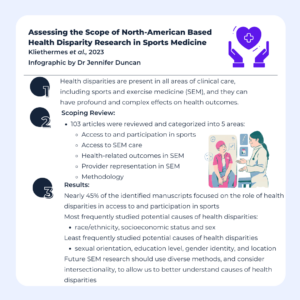Keywords: Health Promotion, Equity-informed Research, Social Determinants of Health
Health disparities are present in all areas of clinical care, including sports and exercise medicine (SEM), and they can have profound and complex effects on health outcomes. However, efforts to understand and address their causes and effects in SEM have not been widely examined – specifically in North America. In conjunction with the American Medical Society for Sports Medicine Collaborative Research Network’s 2023 Research Summit on health disparities, we aimed to summarize the focus areas of North American health disparity research in SEM and to highlight notable gaps in the current evidence base. This blog summarizes our findings and identifies opportunities to advance SEM research in this space and is based on a recent publication (1).
Why is this study important?
We know health disparities, particularly within marginalized communities, lead to negative health outcomes and poorer quality of life due, in part, to restricted access to care and lower quality of care received (2). We also know that sport participation and regular physical activity have positive effects on health and well-being (3,4). In order to eliminate health disparities in SEM, we need to better understand the causes of health disparities and seek to develop and sustain interventions that promote adequate health and healthcare among diverse populations. Gaps in SEM focused health disparity research hinder our ability to tackle these issues.
How did the study go about this?
We systematically searched the literature to identify full-text, peer-reviewed manuscripts that were conducted in North America and focused on organized sports in the year 2000 or later. Using established guidelines for conducting scoping reviews, the study team identified and classified eligible studies into five mutually exclusive primary focus areas. We also recorded potential causes of health disparities that were assessed within each manuscript (e.g. ability, age, sex, gender identity, race/ethnicity).
What did the study find?
The review identified 103 articles that were categorized into five focus areas:
(1) access to and participation in sports
(2) access to SEM care
(3) health-related outcomes in SEM
(4) provider representation in SEM
(5) methodology.
Nearly 45% of the identified manuscripts focused on the role of health disparities in access to and participation in sports while <5% focused on provider representation and methodology, respectively. Race/ethnicity, socioeconomic status and sex were the most studied potential causes of health disparities in SEM whereas potential causes such as sexual orientation, education level, gender identity, and location (rural/urban/suburban) were the least studied. Although many studies considered multiple potential causes of health disparities, it was uncommon for studies to consider the intersection of these potential causes on outcomes of interest.
What are the key take-home points?
Overall, there is a paucity of SEM literature on health disparities and more focused research is necessary to identify meaningful patterns and associations within the complex and interdependent sports landscape. Specifically, researchers, policy makers and clinicians should consider the intersectionality of patient backgrounds and experiences on health outcomes when conducting research, creating policy or delivering care. Future SEM research should strive to be more inclusive and use diverse methodological approaches to allow us to better understand causes of health disparities in marginalized groups. Finally, research must also begin to seek meaningful interventions that successfully reduce these disparities.

References:
- Kliethermes SA, Asif IM, Blauwet C, Christensen L, Coleman N, Lavallee ME, Moeller JL, Phillips SF, Rao A, Rizzone KH, Sund S, Tanji JL, Tuakli-Wosornu YA, Stafford CD 2nd. Focus areas and methodological characteristics of North American-based health disparity research in sports medicine: a scoping review. Br J Sports Med. 2024 Feb 7;58(3):164-171. doi: 10.1136/bjsports-2023-107607. PMID: 38216322.
- National Academies of Sciences, Engineering, and Medicine, Health and Medicine Division, Board on Population Health and Public Health Practice. Communities in Action: Pathways to Health Equity. Washington (DC): National Academies Press (US), 2017
- Eather N, Wade L, Pankowiak A, Eime R. The impact of sports participation on mental health and social outcomes in adults: a systematic review and the ‘Mental Health through Sport’ conceptual model. Syst Rev. 2023 Jun 21;12(1):102. doi: 10.1186/s13643-023-02264-8. PMID: 37344901; PMCID: PMC10286465.
- Martinez MF, Weatherwax C, Piercy K, Whitley MA, Bartsch SM, Heneghan J, Fox M, Bowers MT, Chin KL, Velmurugan K, Dibbs A, Smith AL, Pfeiffer KA, Farrey T, Tsintsifas A, Scannell SA, Lee BY. Benefits of Meeting the Healthy People 2030 Youth Sports Participation Target. Am J Prev Med. 2024 Jan 23:S0749-3797(23)00517-2. doi: 10.1016/j.amepre.2023.12.018. Epub ahead of print. PMID: 38416089.
Authors: Stephanie Kliethermes, PhD, Cheri Blauwet, MD, Katherine H Rizzone, MD, MPH, Jeffery Tanji, MD, Yetsa Tuakli-Wosornu, MD, MPH